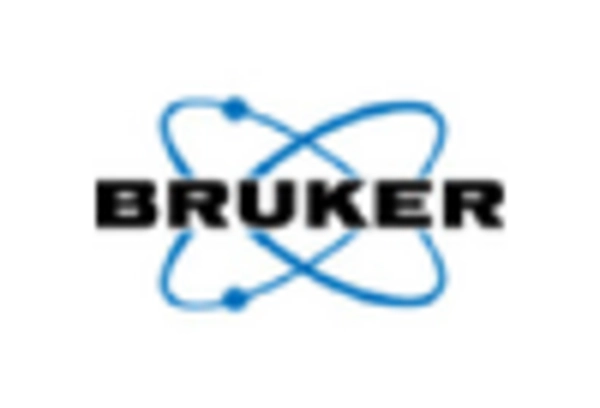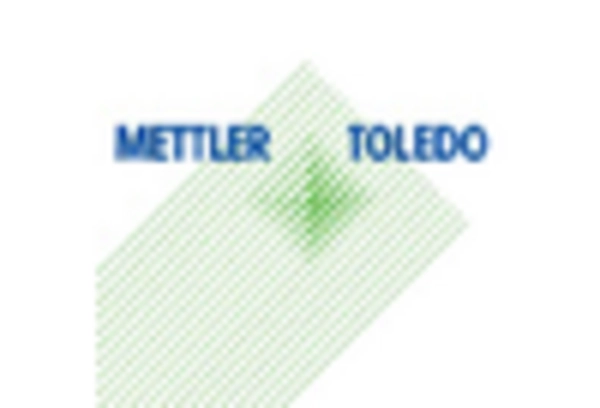Growth in Biotechnology Sector
The biotechnology sector is witnessing rapid growth, which is significantly impacting the laboratory equipment market. With advancements in genetic research, drug development, and personalized medicine, laboratories are increasingly relying on specialized equipment to conduct complex experiments. The biotechnology industry is projected to reach $727 billion by 2025, indicating a substantial opportunity for laboratory equipment manufacturers. This growth is likely to drive demand for equipment such as bioreactors, centrifuges, and analytical instruments that are essential for biotechnological applications. As research in biotechnology continues to evolve, the laboratory equipment market is expected to adapt by offering innovative solutions that cater to the specific needs of this dynamic sector. The interplay between biotechnology advancements and laboratory equipment will likely shape the future landscape of the market.
Increased Focus on Quality Control
Quality control has emerged as a critical driver in the laboratory equipment market, particularly within industries such as pharmaceuticals and food and beverage. The need for stringent quality assurance processes has led to a heightened demand for laboratory equipment that can ensure compliance with industry standards. Regulatory bodies are increasingly emphasizing the importance of quality control, which has resulted in laboratories investing in advanced testing and analytical equipment. This trend is reflected in the laboratory equipment market, which is projected to grow at a CAGR of 6% over the next five years. The integration of automated systems and real-time monitoring technologies is likely to enhance the efficiency of quality control processes, thereby further propelling the laboratory equipment market. As industries continue to prioritize product safety and efficacy, the demand for reliable laboratory equipment will remain robust.
Rising Demand for Advanced Research
The laboratory equipment market is experiencing a notable increase in demand driven by the need for advanced research capabilities across various sectors, including pharmaceuticals, biotechnology, and environmental science. As research institutions and laboratories strive to enhance their operational efficiency, the adoption of sophisticated equipment becomes imperative. This trend is reflected in the projected growth of the laboratory equipment market, which is expected to reach approximately $50 billion by 2026. The emphasis on innovation and precision in research methodologies necessitates the integration of cutting-edge technologies, thereby propelling the laboratory equipment market forward. Furthermore, the increasing complexity of experiments and the need for high-quality results are likely to further stimulate investment in advanced laboratory equipment, ensuring that laboratories remain competitive and effective in their research endeavors.
Expansion of Educational Institutions
The expansion of educational institutions, particularly in the fields of science and technology, is significantly influencing the laboratory equipment market. As universities and colleges enhance their curricula to include more hands-on laboratory experiences, the demand for laboratory equipment is expected to rise. This trend is underscored by the increasing enrollment rates in STEM (Science, Technology, Engineering, and Mathematics) programs, which have seen a growth of over 20% in recent years. Consequently, educational institutions are investing heavily in modern laboratory facilities and equipment to provide students with practical skills. This investment not only supports academic growth but also prepares a skilled workforce for the future, thereby driving the laboratory equipment market. The focus on experiential learning is likely to continue, further solidifying the role of educational institutions as key players in the laboratory equipment market.
Emergence of Smart Laboratory Solutions
The emergence of smart laboratory solutions is transforming the laboratory equipment market, as laboratories increasingly adopt automation and digital technologies. The integration of Internet of Things (IoT) devices and artificial intelligence (AI) into laboratory equipment is enhancing operational efficiency and data management. This trend is indicative of a broader shift towards smart laboratories, where equipment can communicate and share data seamlessly. The laboratory equipment market is projected to benefit from this technological evolution, with an expected growth rate of 7% annually over the next few years. Smart laboratory solutions not only improve productivity but also facilitate real-time monitoring and analysis, which are crucial for modern research. As laboratories seek to optimize their workflows and reduce human error, the demand for smart laboratory equipment is likely to increase, further driving the laboratory equipment market.

















Leave a Comment